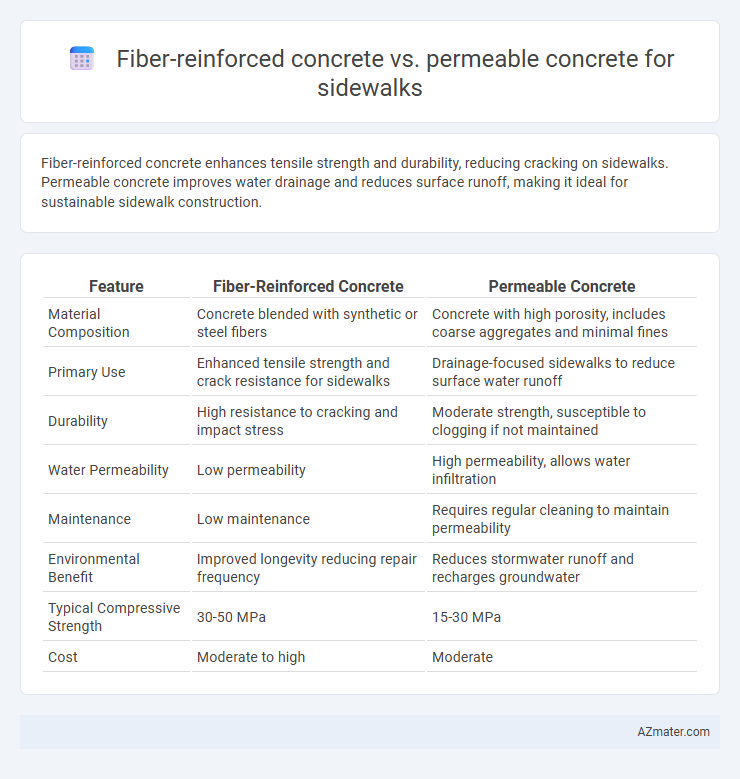Fiber-reinforced concrete enhances tensile strength and durability, reducing cracking on sidewalks. Permeable concrete improves water drainage and reduces surface runoff, making it ideal for sustainable sidewalk construction.
Table of Comparison
| Feature | Fiber-Reinforced Concrete | Permeable Concrete |
|---|---|---|
| Material Composition | Concrete blended with synthetic or steel fibers | Concrete with high porosity, includes coarse aggregates and minimal fines |
| Primary Use | Enhanced tensile strength and crack resistance for sidewalks | Drainage-focused sidewalks to reduce surface water runoff |
| Durability | High resistance to cracking and impact stress | Moderate strength, susceptible to clogging if not maintained |
| Water Permeability | Low permeability | High permeability, allows water infiltration |
| Maintenance | Low maintenance | Requires regular cleaning to maintain permeability |
| Environmental Benefit | Improved longevity reducing repair frequency | Reduces stormwater runoff and recharges groundwater |
| Typical Compressive Strength | 30-50 MPa | 15-30 MPa |
| Cost | Moderate to high | Moderate |
Introduction to Sidewalk Concrete Solutions
Fiber-reinforced concrete enhances durability and crack resistance in sidewalks by integrating synthetic or steel fibers into the mix, ensuring improved load-bearing capacity and longevity. Permeable concrete offers an eco-friendly solution by allowing water to infiltrate through its porous structure, reducing runoff and promoting groundwater recharge in urban sidewalks. Both concrete types address different functional needs, with fiber-reinforced concrete prioritizing strength and crack control, while permeable concrete focuses on sustainable water management.
What is Fiber-Reinforced Concrete?
Fiber-reinforced concrete (FRC) incorporates synthetic, steel, glass, or natural fibers to enhance tensile strength, durability, and crack resistance, making it ideal for sidewalks subject to heavy pedestrian traffic and occasional vehicular loads. Unlike permeable concrete, which prioritizes water drainage through its porous structure, FRC offers improved mechanical performance and longevity by distributing stress and controlling shrinkage cracks. This reinforcement technology reduces maintenance costs and extends sidewalk lifespan in urban environments prone to freeze-thaw cycles and surface wear.
Understanding Permeable Concrete
Permeable concrete for sidewalks features a porous structure that allows water to pass through, reducing surface runoff and enhancing stormwater management. Unlike fiber-reinforced concrete, which improves tensile strength and crack resistance, permeable concrete prioritizes environmental benefits by promoting natural groundwater recharge and reducing urban heat islands. The open-graded mix design of permeable concrete balances durability with permeability, making it an eco-friendly choice for sustainable sidewalk construction.
Strength and Durability Comparison
Fiber-reinforced concrete offers superior tensile strength and crack resistance compared to permeable concrete, making it ideal for high-traffic sidewalks requiring enhanced durability. Permeable concrete excels in water drainage and environmental sustainability but tends to have lower compressive strength and wear resistance than fiber-reinforced alternatives. Both materials provide unique benefits, though fiber-reinforced concrete typically ensures longer lifespan and structural integrity under heavy load conditions.
Permeability and Water Management
Permeable concrete offers superior water permeability, allowing rainwater to infiltrate the ground, reducing runoff and improving groundwater recharge, which is essential for sustainable water management in sidewalks. Fiber-reinforced concrete enhances structural strength and crack resistance but typically exhibits lower permeability compared to permeable concrete, limiting its effectiveness in managing stormwater. For sidewalks prioritizing water drainage and preventing flooding, permeable concrete is a more effective solution due to its high porosity and efficient water absorption properties.
Installation and Maintenance Requirements
Fiber-reinforced concrete requires careful mixing to evenly distribute synthetic or steel fibers, ensuring enhanced tensile strength and crack resistance, while its installation demands precise finishing to maintain durability and surface integrity. Permeable concrete installation involves specialized techniques to create a porous matrix allowing water infiltration, which requires consistent compaction and avoidance of clogging materials during placement. Maintenance for fiber-reinforced concrete typically focuses on crack monitoring and cleaning, whereas permeable concrete necessitates regular vacuuming or pressure washing to prevent pore blockage and sustain permeability.
Environmental Impact of Each Material
Fiber-reinforced concrete enhances durability, reducing maintenance and the need for frequent replacements, which lowers the environmental footprint related to resource extraction and waste generation. Permeable concrete significantly improves stormwater management by allowing water infiltration, decreasing runoff pollution and recharging groundwater while mitigating urban heat island effects. Both materials offer distinct environmental benefits: fiber-reinforced concrete minimizes lifecycle emissions through longevity, while permeable concrete supports sustainable water cycle management in urban infrastructure.
Cost Factors: Initial and Long-Term
Fiber-reinforced concrete typically incurs higher initial costs due to specialized materials and mixing processes but offers enhanced durability and reduced maintenance expenses over time. Permeable concrete has moderate upfront costs but may require more frequent repairs or replacements in heavy use areas, impacting long-term affordability. Evaluating lifecycle costs, including installation, maintenance, and repair, is critical for selecting the most cost-effective sidewalk material.
Best Use Cases for Each Concrete Type
Fiber-reinforced concrete offers enhanced tensile strength and crack resistance, making it ideal for sidewalks in areas with heavy pedestrian traffic or where structural durability is critical, such as urban sidewalks and industrial zones. Permeable concrete excels in stormwater management by allowing water to infiltrate through its porous structure, making it best suited for sidewalks in regions with high rainfall or strict environmental regulations to reduce runoff. Choosing between these concrete types depends on prioritizing either structural integrity and durability or environmental sustainability and water management for the specific sidewalk application.
Choosing the Right Concrete for Your Sidewalk
Fiber-reinforced concrete offers enhanced durability and crack resistance, making it ideal for sidewalks subject to heavy pedestrian traffic and varying weather conditions. Permeable concrete promotes water drainage and reduces runoff, which benefits environmentally-conscious projects in areas with frequent rainfall or strict stormwater regulations. Selecting the right concrete depends on balancing durability needs with environmental goals, ensuring long-term performance and sustainability for your sidewalk.

Infographic: Fiber-reinforced concrete vs Permeable concrete for Sidewalk
 azmater.com
azmater.com